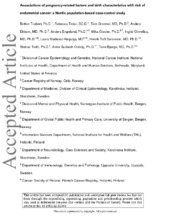Associations of pregnancy-related factors and birth characteristics with risk of endometrial cancer: A Nordic population-based case-control study
Trabert, Britton; Troisi, Rebecca; Grotmol, Tom; Ekbom, Anders; Engeland, Anders; Gissler, Mika; Glimelius, Ingrid; Madanat-Harjuoja, Laura M.; Sørensen, Henrik Toft; Tretli, Steinar; Ording, Anne Gulbech; Bjørge, Tone
Peer reviewed, Journal article
Accepted version
Permanent lenke
https://hdl.handle.net/1956/20710Utgivelsesdato
2020Metadata
Vis full innførselSamlinger
Originalversjon
https://doi.org/10.1002/ijc.32494Sammendrag
Many pregnancy‐related factors are associated with reduced endometrial cancer risk. However, it remains unclear whether pregnancy‐related complications (e.g., hypertensive conditions) are associated with risk and whether these associations vary by endometrial cancer subtype. Thus, we evaluated the risk of endometrial cancer, overall and by subtype, in relation to pregnancy‐related factors, pregnancy complications and birth characteristics. Utilizing population‐based register data from four Nordic countries, we conducted a nested case–control analysis of endometrial cancer risk. We included 10,924 endometrial cancer cases and up to 10 matched controls per case. Odds ratios (ORs) with 95% confidence intervals (CIs) were derived from unconditional logistic regression models. We further evaluated associations by individual histology (i.e., endometrioid, serous, etc.) or, for rare exposures (e.g., pregnancy complications), by dualistic type (Type I [n = 10,343] and Type II [n = 581]). Preexisting and pregnancy‐related hypertensive conditions were associated with increased endometrial cancer risk (OR [95% CI]: preexisting hypertension 1.88 [1.39–2.55]; gestational hypertension 1.47 [1.33–1.63]; preeclampsia 1.43 [1.30–1.58]), with consistent associations across dualistic type. Increasing number of pregnancies (≥4 vs. 1 birth: 0.64 [0.59–0.69]) and shorter time since last birth (<10 vs. ≥30 years: 0.34 [0.29–0.40]) were associated with reduced endometrial cancer risk, with consistent associations across most subtypes. Our findings support the role for both hormonal exposures and cell clearance as well as immunologic/inflammatory etiologies for endometrial cancer. This research supports studying endometrial hyperplasia, a precursor condition of endometrial cancer, in the context of pregnancy‐related exposures, as this may provide insight into the mechanisms by which pregnancy affects subsequent cancer risk.
